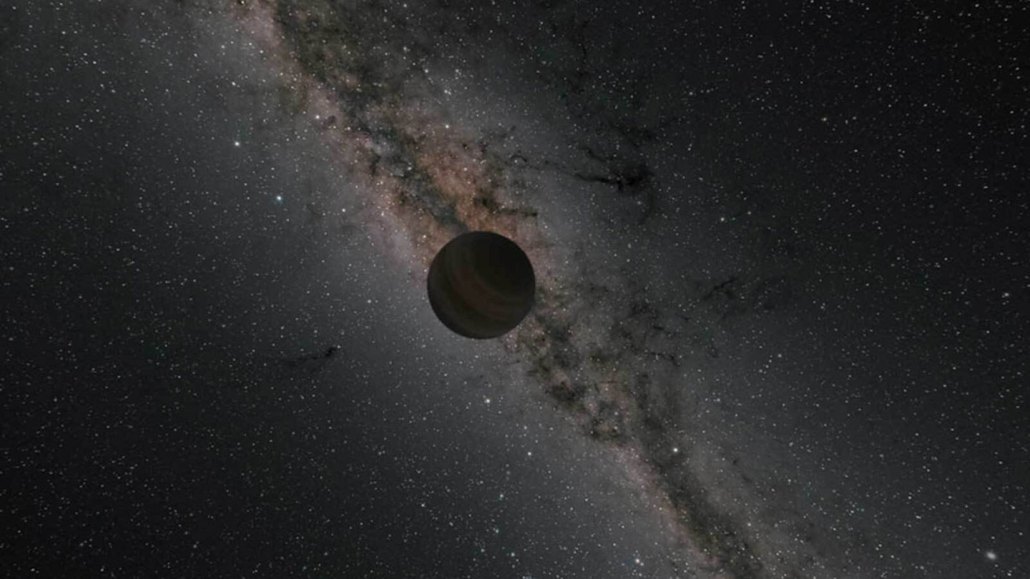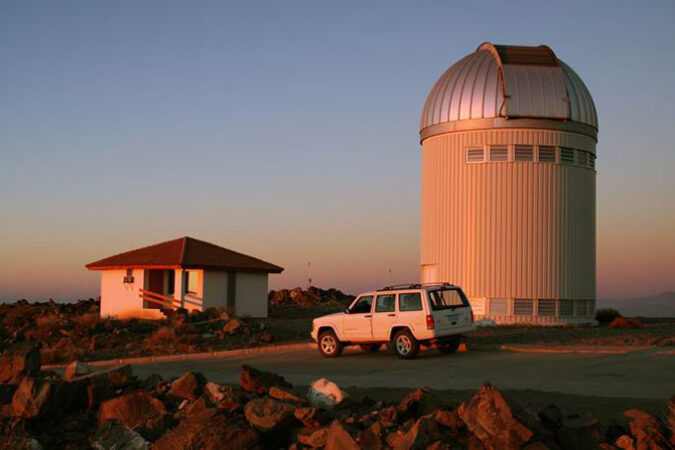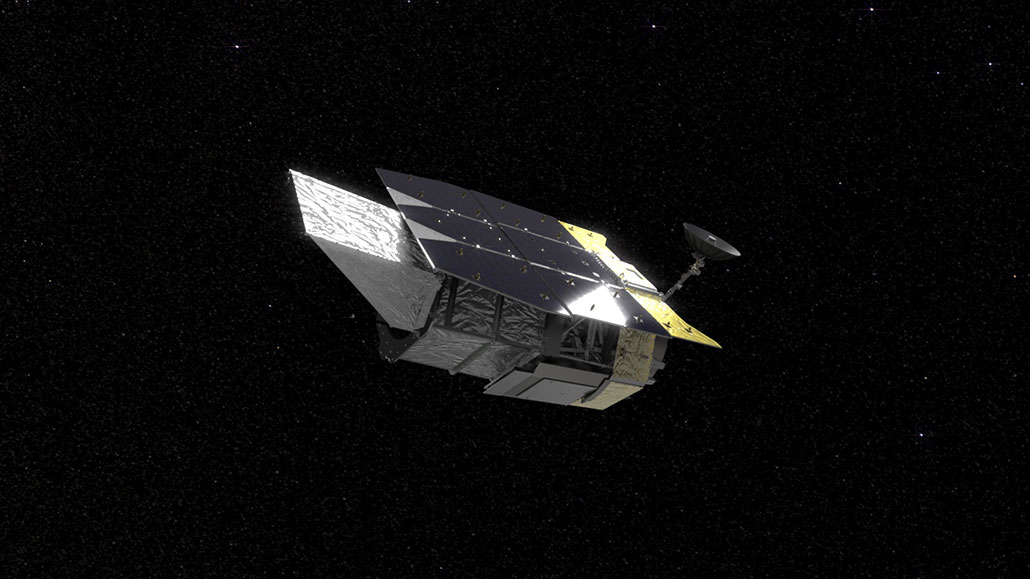Rogue planets wander the galaxy all alone
The latest of these starless orphans to turn up is about massive as Earth

A newfound planet (seen here in an illustration) is about the mass of Earth and has no sun. Instead, it floats through the galaxy alone.
NASA/JPL-Caltech/R. Hurt (Caltech-IPAC)
Share this:
- Share via email (Opens in new window) Email
- Click to share on Facebook (Opens in new window) Facebook
- Click to share on X (Opens in new window) X
- Click to share on Pinterest (Opens in new window) Pinterest
- Click to share on Reddit (Opens in new window) Reddit
- Share to Google Classroom (Opens in new window) Google Classroom
- Click to print (Opens in new window) Print
Not all planets orbit stars. Some zip through our galaxy all on their own. And now astronomers have found the smallest of these rogue planets yet.
The newly discovered wandering world has roughly the mass of Earth. With no sun in its sky, it’s always nighttime on this lonely planet. And that sky is a lot darker and filled with more stars than can be seen from any place on Earth.
“The sky must be marvelous,” says Przemek Mróz. He is an astronomer at Caltech in Pasadena, Calif. He led the team that discovered the planet. But the lack of a sun does come at a cost, he says. “It must be freezing cold, too.”
This drifter joins a small club. Over the last 20 years, astronomers have found fewer than two dozen planets without stars in our galaxy. Most are big balls of gas that are more like Jupiter than Earth. But scientists think these worlds are the tip of an enormous iceberg. In our galaxy alone, there might be billions out there awaiting discovery.
A valuable planet
Finding this tiny planet is “very valuable,” says Diana Dragomir. She’s an astronomer at the University of New Mexico in Albuquerque. She looks for planets around stars other than our sun. This work is helping her figure out how many worlds other than Earth may be home to some type of life. There’s probably nothing alive on this dark, frigid orphan planet. But its discovery gives Dragomir and other scientists information about worlds that are difficult to find.
“The fact that we found it means a lot, even if it’s just floating, because it means it formed in the first place,” she says.
Astronomers think that orphaned planets formed in solar systems like our own. But something kicked the planet out. Maybe the gravity of a larger world gave a planet the boot. Or perhaps a passing star got too close, and its gravity snagged a planet or two.
Dragomir says this newfound world probably formed pretty far from its home star. If it were too close, then the star’s gravity would have kept it from escaping.
Planets, especially small ones, that are far from their stars are often tricky to find. “Even though we think that there are distant planets around many, many stars, we cannot know for sure,” says Dragomir. “Finding even just one like this one, using another technique, is really helpful because it’s adding to a pretty small sample.” She adds that the discovery of this wandering planet is “telling us these small planets at a reasonable distance from their star do form.”
When is a planet not a planet?
Most people think of planets as objects that orbit stars. In fact, the official definition says a planet must orbit a star. Specifically, our sun. Rogue planets don’t meet this definition, which was decided on by the International Astronomical Union, or IAU, notes Jessie Christiansen. She’s an astronomer at Caltech. Like Dragomir, she also is tallying all the types of planets that are out there. The IAU is the group that decides on official definitions and names for things in space.
But many now argue a planet should be defined only by how it formed. The IAU goes on to say that a planet is anything that’s big enough so that its gravity molds itself into a ball. Otherwise it would be a lumpy asteroid or comet. But the object can’t be so massive that it crushes together atoms and starts to glow. Then it would be a star.
Based on their mass, rogue planets pass inspection. But “our institutions have not caught up to the fact that these planets exist yet,” says Christiansen.
“NASA is literally rewriting the definition right now,” she says. NASA keeps track of planets found outside our solar system in a computer database. It’s called the NASA Exoplanet Archive. (An exoplanet is any planet that doesn’t orbit our sun.) But Dragomir says this database does not yet include orphan worlds. “We’re in the process of redesigning our archives so that we can host them,” she says.
Really low odds
Astronomers find most planets by detecting how they influence the stars they orbit. That, of course, won’t work for the orphans. They also don’t emit light, so astronomers can’t see them directly.
However, orphan planets can alter the light from stars that are much farther away. The process is known as gravitational lensing.
If something in space passes between Earth and a star, the object’s gravity focuses light from that star onto Earth. “It’s like a magnifying lens,” Mróz says. To someone on Earth, the star brightens as the object passes by. And that’s how researchers discovered this tiny rogue planet.
In June 2016, a faint star in the constellation Sagittarius brightened a bit. It then faded back to normal. Mróz and his team measured how long it took the star to brighten and dim. The change took about five hours. That told them the approximate mass of the passing object. They estimate that its mass could be as little as one-third the mass of Earth or as much as twice as massive as our planet. They shared their discovery November 1 in Astrophysical Journal Letters.
Mróz and his team noticed the planet with a telescope called OGLE. That stands for Optical Gravitational Lensing Experiment. The telescope sits in the Atacama Desert of Chile. It stares toward parts of our Milky Way that have lots of stars, such as the center of the galaxy. It then looks for changes in starlight caused by dark objects floating by.
The odds of finding just one object are, well, astronomical. The alignment between Earth, some object and a background star has to be almost perfect. “If you observed only one star, you would need to wait on average a million years” before anything passed by, says Mróz.
No one wants to wait that long. So to increase their chances, instead of watching one star, scientists watch millions. The OGLE telescope monitors the same 200 million stars every clear night, notes Mróz. That lets them find a couple thousand floaters every year, though most are just dim stars.

What’s next
This teeny planet pushes the limit of what telescopes like OGLE can do, says Mróz. To find lots more, astronomers need a telescope in space that’s up to the challenge.
That’s where the Nancy Grace Roman Space Telescope comes in. It’s due to launch around 2025. It will be as large as the Hubble Space Telescope, but it will see 100 times more of the sky at once. The new telescope is named after Nancy Grace Roman, NASA’s first chief astronomer. In 1959, she wrote that putting a telescope in space would let astronomers find planets around other stars. (Her namesake telescope won’t be the first such planet-finding telescope in space. The Kepler space telescope, for example, found more than 2,700 exoplanets before running out of gas in 2018.)
The Roman telescope will orbit far above Earth’s shaky atmosphere. From there, it will be able to find many roaming planets (and do lots of other science, too).

“Right now, we know very little about free-floating planets,” says Samson Johnson. He is an astronomer at The Ohio State University in Columbus. Recently, he and other scientists calculated how many floating planets the Roman telescope might find. They estimate it could find at least 250, some as tiny as Mars. They reported these results in the September Astronomical Journal.
Such discoveries could tell astronomers a lot about how planets form. Some of the solar systems in our galaxy show hints of past messiness. They are home to planets with orbits that are tilted and spaced out in strange ways. But other solar systems are neat and orderly.
“One of the questions going forward is, which is more common?” Christiansen says. If the Roman telescope turns up lots of floating planets, she says, then it may indicate planets get kicked out of their homes often. And that may mean that many young planetary systems are messy.
Even our own solar system was once chaotic. But for hundreds of years, astronomers assumed our solar system has always looked the way it does now: nice and organized. They also thought other planetary systems would be similar to ours. But the variety of worlds we’ve discovered, including orphan planets, shows this isn’t the case. And some scientists now think that that our solar system lost a planet long ago.
“One of the nice, most amazing, and exciting things that came out of exoplanets,” says Christiansen, “is discovering that there are so many different types of planetary systems out there.”







